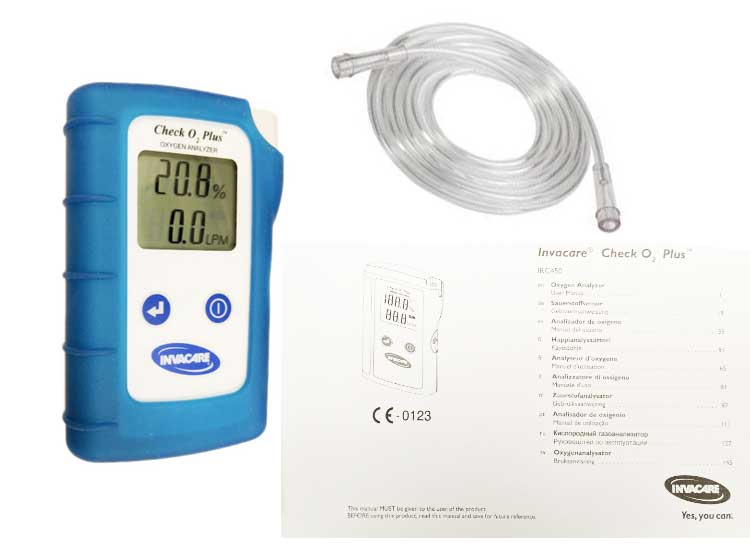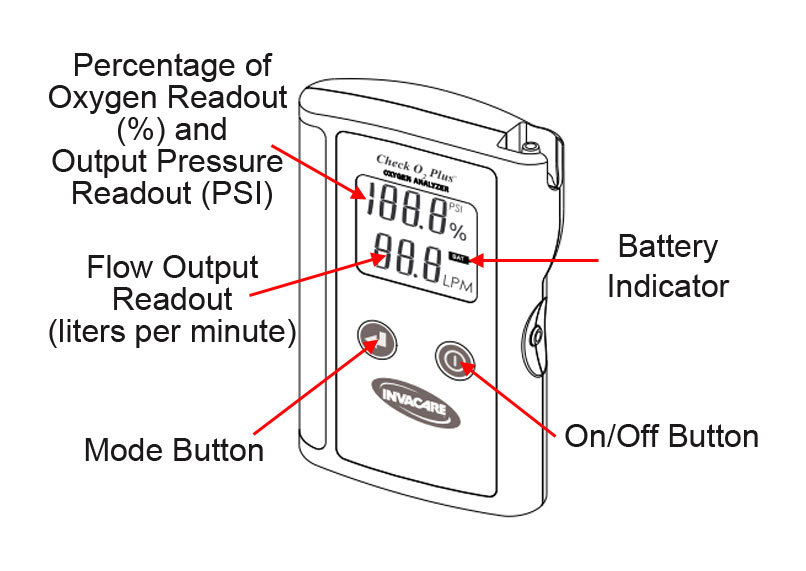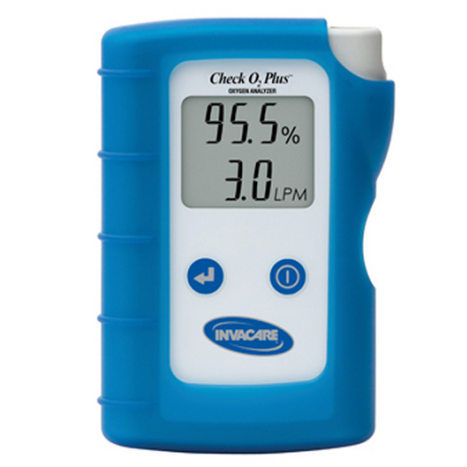Check O2 Plus Oxygen Analyzer (Invacare IRC450) Overview
Invacare Check O2 Plus Oxygen Analyzer (Invacare IRC450 replaces IRC400) is an efficient and cost-effective tester designed with technicians in mind. It includes the connection to make three separate assesments: 1) oxygen purity concentration percentage, 2) flow rate in liters per minute, and 3) oxygen outlet pressure (psi/kPa) on any home or portable Oxygen Concentrator. This Oxygen Analyzer is very low maintenance and never needs to be calibrated. This tester features simple, two button operation. The device is powered by two AA batteries that provide over 16,000 readings before they need replacing or recharging. the Invacare oxygen analyzer is very efficient and will even shut off automatically after four minutes to extend battery life.

Product Components
- O2 Analyzer
- Gas Sample Tubing
- Soft Protective Cover
- User Manual
Components Description
- 3 1/2 Digit Display — LCD provides direct readout of concentration, gas flow and gas pressure. The LCD also displays error codes as necessary.
- ON/OFF Button — Turns the unit on or off.
- Mode Button — Switches between measuring the concentration of gas produced by a concentrator and pure oxygen (for calibration verification).
- Low Battery Indicator — Indicates the voltage of the batteries is below normal operating levels.
- LPM — Illuminated next to the flow measurement. (not shown when in calibration verification mode)
- kPA — Indicates the pressure measurement in units of kilopascals.
- PSI — Indicates the pressure measurement in units of pounds per square inch.
- "%" symbol — Illuminated next to the concentration measurements.
- Inlet Port — Used to receive the gas sample.
- Outlet Port— Used as an outlet for the gas sample and as a trigger for pressure measurement when occluded.
- Oxygen Tubing — Used to connect to gas sample port.
Low Oxygen Levels
Periodically checking the oxygen output levels of your o2 concentrator is important. Settings can change. The altitude the concentrator is operating at can degrade the performance of the concentrator. Diagnosing the actual output and adjusting the controls accordingly can help ensure you always get the amount of oxygen your need. Below are some symptoms experienced by oxygen patients when their oxygen level is too low.
- Dizziness
- Confusion
- Shortness of Breath
- Headache
- Restlessness
- Chest Pain
- Rapid Breathing
- High Blood Pressure
- Hypoxemia
Features and Benefits

- Durable, Compact Design
- Effectively Measures Oxygen Purity, Flow Rate and Outlet Pressure
- Simple 2 Button Operation
- Auto-Battery Shut-Off After 4 Minutes
- Long Battery Life
- Easy to Clean
- Compact Design
- Comes with Connection Tube
- No Calibration Required
- Three Oxygen Analyzers Rolled Into One
- Protective Cover
- Low Battery Indicator
- Self-Diagnostics
- Shielded, Reinforced Sample Gas Inlet Port
- Large, Easy-to-Read, Liquid Crystal Display (LCD)
- Convenient Ability to Measure Pressure in PSI or kPa
- No In-Field Calibration Required
Product Specifications

Size
- Width: 3.16 Inch
- Length: 5.10 Inch
- Depth: 1.04 Inch
- Weight: 6.4 Ounces
- Shipping Weight: 1 lbs.
- Color: White with Blue Protective Cover
Performance and Operation
- Flow Measurement Range: 0 to 10 LPM +/- .5%
- Oxygen Measurement Range: 21% to 95.6%
- Pressure Measurement Range: 0.5-50 PSI
- Power Source: Two AA Batteries
- Battery Life: 1,100 Hours or 16,000 readings
Manufacturing and Quality
- Product Number: IRC450
- IRC450 Replaces the Old IRC400
- Warranty: 3 years, limited
Does the device need to be calibrated?
This device provides self-diagnostics and does not require any in-field calibration.
Cautions
- Not for use in anesthesia applications or for measuring oxygen concentration from any sources other than conventional oxygen concentrators.
- Not for use with inhalation agents. Operating the device in flammable or explosive environments may result in fire or explosion.
- Not suitable for use in the presence of flammable anesthetic mixtures.
- Oxygen rapidly accelerates combustion. Do not smoke while using the device.
- NOT for use in an MRI environment.
- Replace the batteries with high-quality AA Alkaline or Lithium batteries. DO NOT use rechargeable batteries.
- When not in use for periods greater than 30 days remove the batteries to protect the device from potential battery leakage.
- Avoid dropping the device to prevent damage which may adversely affect its performance. If damage to the device is suspected, perform 4.3 Calibration Verification Procedure, page 10 of the User Manual.
- Avoid foreign matter entry into the unit.
- DO NOT use the device to check a concentrator with a humidifier in place. Humidity could damage the device.
- DO NOT use on a concentrator while holding the mode button or the reading will be inaccurate.
- Following storage in extremely hot or cold conditions, allow the gas to flow through the unit long enough for the internal sensors to reach the gas stream temperature, or wait for the machine to equilibrate to room temperature before use.


Login and Registration Form